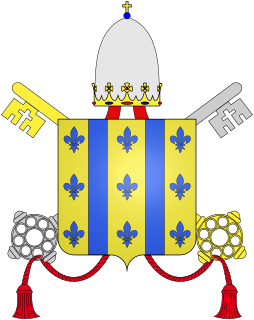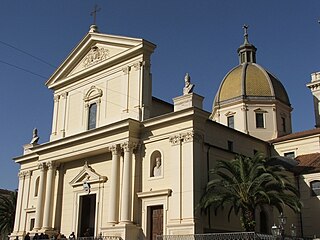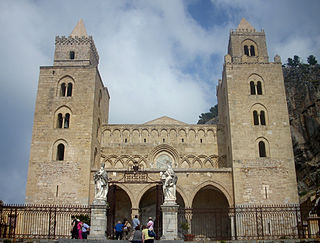Related Research Articles

Pope Innocent V, born Pierre de Tarentaise, was head of the Catholic Church and ruler of the Papal States from 21 January to 22 June 1276. A member of the Order of Preachers, he acquired a reputation as an effective preacher. He held one of the two "Dominican Chairs" at the university of Paris, and was instrumental in helping with drawing up the "program of studies" for the Order. In 1269, Peter of Tarentaise was Provincial of the French Province of Dominicans. He was a close collaborator of Pope Gregory X, who named him Bishop of Ostia and raised him to cardinal in 1273.

Minervino Murge is a town and comune, former bishopric and present Latin Catholic titular see in the administrative province of Barletta-Andria-Trani in the region of Apulia in southern Italy, lying on the western flank of the Murgia Barese mountain chain.

Strongoli is a comune and town with a population of over 6000 people in the province of Crotone, in Calabria, southernmost Italy.
The diocese of Cagli e Pergola was a Roman Catholic ecclesiastical territory in the Marche, central Italy, in the province of Pesaro and Urbino. Up until 1563 it was under the direct supervision of the Roman pontiff. In that year, the diocese of Urbino was elevated to metropolitan status, and Cagli became a suffragan see of Urbino. The diocese was abolished as an independent entity in 1986, when it was incorporated into the diocese of Fano-Fossombrone-Cagli-Pergola. It was still a suffragan of the archdiocese of Urbino.

The Archdiocese of Reggio Calabria-Bova is a Latin Church ecclesiastical territory or diocese of the Catholic Church in Calabria, southern Italy. It received its current title in 1986, when the independent Diocese of Bova was suppressed, and the territory and title of the diocese added to that of the Archdiocese of Reggio.

The Diocese of Cassano all'Jonio is a Roman Catholic diocese in Calabria.

The Italian Catholic Diocese of Mazara del Vallo is in far western Sicily. It is a suffragan of the Archdiocese of Palermo.

The Roman Catholic Archdiocese of Trani-Barletta-Bisceglie is a Latin rite archbishopric in the administrative province of Barletta-Andria-Trani, in the southeastern Italian region of Apulia. In 1980 it became a suffragan diocese in the ecclesiastical province of the Archdiocese of Bari-Bitonto, when it was demoted to non-Metropolitan status. It received its current name in 1986, when the Archbishopric of Trani added to its title the names of two suppressed bishoprics merged into it.

The Archdiocese of Siracusa, also known as Syracuse, is a Latin Church ecclesiastical territory or diocese of the Catholic Church in Sicily. It became an archdiocese in 1844. The current archbishop is Francesco Lomanto.

The Roman Catholic Archdiocese of Bari-Bitonto is Metropolitan Latin rite archbishopric in the administrative Bari province, Puglia (Apulia) region, southeastern Italy, created in 1986, when the historical diocese of Bitonto was subsumed in the Archdiocese of Bari.

The diocese of Molfetta-Ruvo-Giovinazzo-Terlizzi is a Roman Catholic ecclesiastical territory in Apulia, southern Italy, which was established in 1986, when the diocese of Molfetta-Giovinazzo-Terlizzi was united with the diocese of Ruvo. Giovinazzo is only four miles south-east of Molfetta along the Adriatic coast, and Ruvo only ten miles inland to the south-west; Terlizzi is likewise only four miles from Molfetta, some four miles nearer than Ruvo. The historical diocese of Molfetta was expanded in 1818. The current diocese is a suffragan of the archdiocese of Bari-Bitonto.

The Italian Roman Catholic diocese of Conversano-Monopoli, in Apulia, has existed since 1986, when the diocese of Monopoli was united with the historic diocese of Conversano. The diocese is a suffragan of the Archdiocese of Bari-Bitonto.

The Roman Catholic Diocese of Castellaneta is in Apulia. It is a suffragan of the Roman Catholic Archdiocese of Taranto.

The Italian Catholic Archdiocese of Catanzaro-Squillace in Calabria, has existed in its current form since 1986. In that year the Archdiocese of Catanzaro became a metropolitan see, and was combined with the diocese of Squillace.

The Italian Catholic Diocese of Lamezia Terme is in Calabria. In 1818 the ancient see of Martirano, the former Mamertum, was united to the diocese of Nicastro. The diocese was then a suffragan of the archdiocese of Reggio in Calabria. In 1986, the historic Diocese of Nicastro had its name changed. It is currently called the Diocese of Lamezia Terme, and it is a suffragan of the Archdiocese of Catanzaro-Squillace. The name change reflects the incorporation of the comune of Nicastro into Lamezia Terme, an administrative change of 1968 on the part of the State of Italy.

The Diocese of Cefalù is a Roman Catholic ecclesiastical territory in Sicily, southern Italy. It is a suffragan of the Archdiocese of Palermo.
The Italian Catholic diocese of Lacedonia, a suffragan of the archdiocese of Benevento in Campania, existed until 1986 when incorporated into the reorganized Roman Catholic Diocese of Ariano Irpino-Lacedonia.
The former Roman Catholic Diocese of Sant'Agata de' Goti, in the Province of Benevento, Campania, southern Italy, was a suffragan of the Archdiocese of Benevento from 969 till its 1986 merger into the Diocese of Cerreto Sannita-Telese-Sant'Agata de' Goti.
Enrico Filangieri was an Italian nobleman and Dominican friar who served as the archbishop of Bari in the Kingdom of Sicily from May 1252 until his death.
Filippo da Pistoia, also called Filippo Fontana or anglicized Philip, was an Italian prelate, military leader and diplomat. He was the bishop-elect of Ferrara from 1239 until 1252, bishop-elect of Florence from 1250 until 1251 and archbishop of Ravenna from 1250 until his death. He was the apostolic legate in Germany between July 1246 and March 1247, in Lombardy and the Trevigiana between December 1255 and August 1258 and throughout northern Italy between 1267 and February 1270. He served as podestà (mayor) of Ravenna in 1254.
References
- 1 2 3 4 5 6 Williel R. Thomson (1975), Friars in the Cathedral: The First Franciscan Bishops 1226–1261 (Toronto: Pontifical Institute of Mediaeval Studies), pp. 179–80.
- 1 2 Norbert Kamp (1975), Kirche und Monarchie im staufischen Königreich Sizilien, 1: Prosopographische Grundlegung: Bistümer und Bischöfe des Königreichs 1194–1266, 2: Apulien und Kalabrien (Munich: Wilhelm Fink), pp. 596–601.
- ↑ Björn K. U. Weiler (2006), Henry III of England and the Staufen Empire, 1216–1272 (Woodbridge: Boydell Press), p. 150.